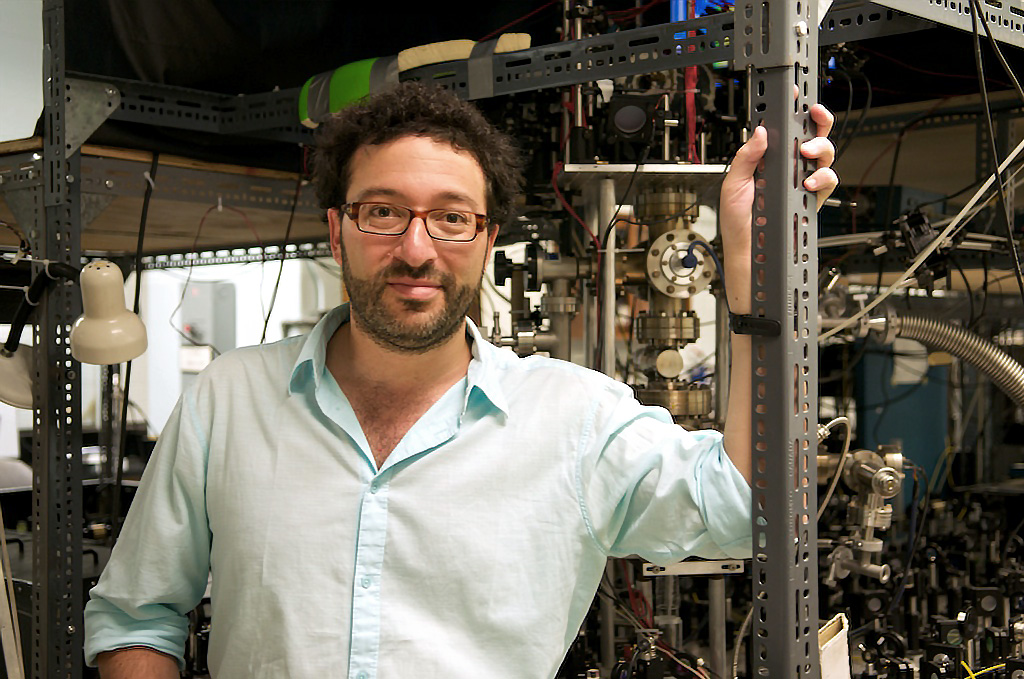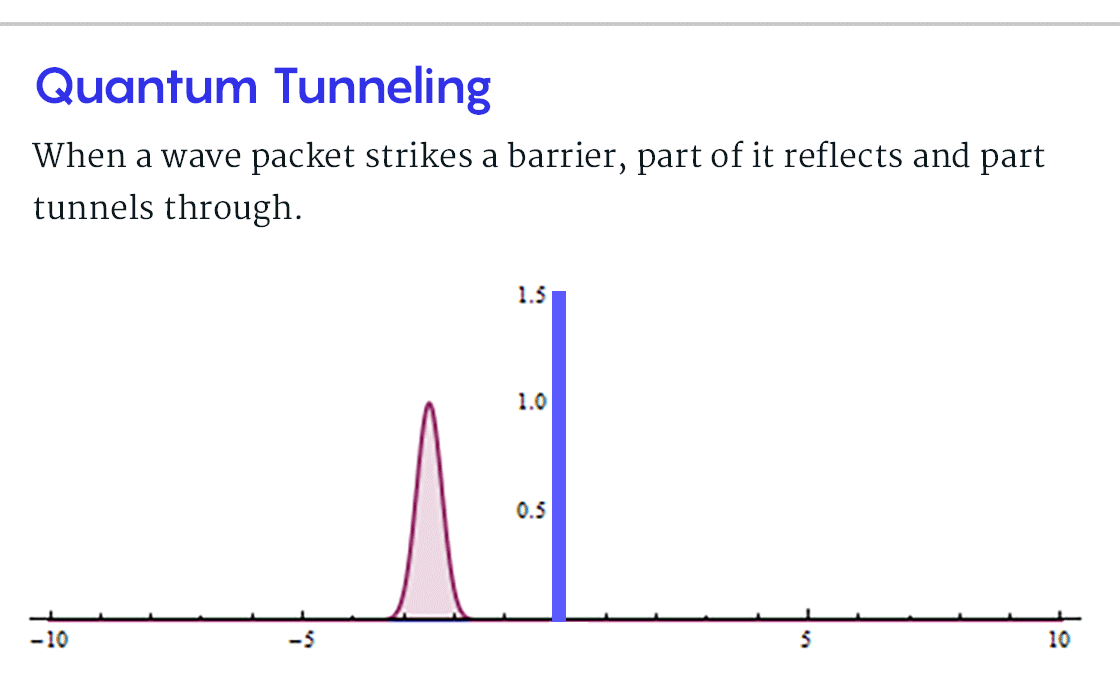Quantum Tunnels Show How Particles Can Break the Speed of Light
Introduction
No sooner had the radical equations of quantum mechanics been discovered than physicists identified one of the strangest phenomena the theory allows.
“Quantum tunneling” shows how profoundly particles such as electrons differ from bigger things. Throw a ball at the wall and it bounces backward; let it roll to the bottom of a valley and it stays there. But a particle will occasionally hop through the wall. It has a chance of “slipping through the mountain and escaping from the valley,” as two physicists wrote in Nature in 1928, in one of the earliest descriptions of tunneling.
Physicists quickly saw that particles’ ability to tunnel through barriers solved many mysteries. It explained various chemical bonds and radioactive decays and how hydrogen nuclei in the sun are able to overcome their mutual repulsion and fuse, producing sunlight.
But physicists became curious — mildly at first, then morbidly so. How long, they wondered, does it take for a particle to tunnel through a barrier?
The trouble was that the answer didn’t make sense.
The first tentative calculation of tunneling time appeared in print in 1932. Even earlier stabs might have been made in private, but “when you get an answer you can’t make sense of, you don’t publish it,” noted Aephraim Steinberg, a physicist at the University of Toronto.
It wasn’t until 1962 that a semiconductor engineer at Texas Instruments named Thomas Hartman wrote a paper that explicitly embraced the shocking implications of the math.
Hartman found that a barrier seemed to act as a shortcut. When a particle tunnels, the trip takes less time than if the barrier weren’t there. Even more astonishing, he calculated that thickening a barrier hardly increases the time it takes for a particle to tunnel across it. This means that with a sufficiently thick barrier, particles could hop from one side to the other faster than light traveling the same distance through empty space.
In short, quantum tunneling seemed to allow faster-than-light travel, a supposed physical impossibility.
“After the Hartman effect, that’s when people started to worry,” said Steinberg.
The discussion spiraled for decades, in part because the tunneling-time question seemed to scratch at some of the most enigmatic aspects of quantum mechanics. “It’s part of the general problem of what is time, and how do we measure time in quantum mechanics, and what is its meaning,” said Eli Pollak, a theoretical physicist at the Weizmann Institute of Science in Israel. Physicists eventually derived at least 10 alternative mathematical expressions for tunneling time, each reflecting a different perspective on the tunneling process. None settled the issue.
But the tunneling-time question is making a comeback, fueled by a series of virtuoso experiments that have precisely measured tunneling time in the lab.

Aephraim Steinberg, a physicist at the University of Toronto, has pursued the tunneling-time question for decades.
Matthew Ross
In the most highly praised measurement yet, reported in Nature in July, Steinberg’s group in Toronto used what’s called the Larmor clock method to gauge how long rubidium atoms took to tunnel through a repulsive laser field.
“The Larmor clock is the best and most intuitive way to measure tunneling time, and the experiment was the first to very nicely measure it,” said Igor Litvinyuk, a physicist at Griffith University in Australia who reported a different measurement of tunneling time in Nature last year.
Luiz Manzoni, a theoretical physicist at Concordia College in Minnesota, also finds the Larmor clock measurement convincing. “What they measure is really the tunneling time,” he said.
The recent experiments are bringing new attention to an unresolved issue. In the six decades since Hartman’s paper, no matter how carefully physicists have redefined tunneling time or how precisely they’ve measured it in the lab, they’ve found that quantum tunneling invariably exhibits the Hartman effect. Tunneling seems to be incurably, robustly superluminal.
“How is it possible for [a tunneling particle] to travel faster than light?” Litvinyuk said. “It was purely theoretical until the measurements were made.”
What Time?
Tunneling time is hard to pin down because reality itself is.
At the macroscopic scale, how long an object takes to go from A to B is simply the distance divided by the object’s speed. But quantum theory teaches us that precise knowledge of both distance and speed is forbidden.
In quantum theory, a particle has a range of possible locations and speeds. From among these options, definite properties somehow crystallize at the moment of measurement. How this happens is one of the deepest questions.
The upshot is that until a particle strikes a detector, it’s everywhere and nowhere in particular. This makes it really hard to say how long the particle previously spent somewhere, such as inside a barrier. “You cannot say what time it spends there,” Litvinyuk said, “because it can be simultaneously two places at the same time.”
To understand the problem in the context of tunneling, picture a bell curve representing the possible locations of a particle. This bell curve, called a wave packet, is centered at position A. Now picture the wave packet traveling, tsunami-like, toward a barrier. The equations of quantum mechanics describe how the wave packet splits in two upon hitting the obstacle. Most of it reflects, heading back toward A. But a smaller peak of probability slips through the barrier and keeps going toward B. Thus the particle has a chance of registering in a detector there.

But when a particle arrives at B, what can be said about its journey, or its time in the barrier? Before it suddenly showed up, the particle was a two-part probability wave — both reflected and transmitted. It both entered the barrier and didn’t. The meaning of “tunneling time” becomes unclear.
And yet any particle that starts at A and ends at B undeniably interacts with the barrier in between, and this interaction “is something in time,” as Pollak put it. The question is, what time is that?
Steinberg, who has had “a seeming obsession” with the tunneling-time question since he was a graduate student in the 1990s, explained that the trouble stems from the peculiar nature of time. Objects have certain characteristics, like mass or location. But they don’t have an intrinsic “time” that we can measure directly. “I can ask you, ‘What is the position of the baseball?’ but it makes no sense to ask, ‘What is the time of the baseball?’” Steinberg said. “The time is not a property any particle possesses.” Instead, we track other changes in the world, such as ticks of clocks (which are ultimately changes in position), and call these increments of time.
But in the tunneling scenario, there’s no clock inside the particle itself. So what changes should be tracked? Physicists have found no end of possible proxies for tunneling time.
Tunneling Times
Hartman (and LeRoy Archibald MacColl before him in 1932) took the simplest approach to gauging how long tunneling takes. Hartman calculated the difference in the most likely arrival time of a particle traveling from A to B in free space versus a particle that has to cross a barrier. He did this by considering how the barrier shifts the position of the peak of the transmitted wave packet.
But this approach has a problem, aside from its weird suggestion that barriers speed particles up. You can’t simply compare the initial and final peaks of a particle’s wave packet. Clocking the difference between a particle’s most likely departure time (when the peak of the bell curve is located at A) and its most likely arrival time (when the peak reaches B) doesn’t tell you any individual particle’s time of flight, because a particle detected at B didn’t necessarily start at A. It was anywhere and everywhere in the initial probability distribution, including its front tail, which was much closer to the barrier. This gave it a chance to reach B quickly.
Since particles’ exact trajectories are unknowable, researchers sought a more probabilistic approach. They considered the fact that after a wave packet hits a barrier, at each instant there’s some probability that the particle is inside the barrier (and some probability that it’s not). Physicists then sum up the probabilities at every instant to derive the average tunneling time.
As for how to measure the probabilities, various thought experiments were conceived starting in the late 1960s in which “clocks” could be attached to the particles themselves. If each particle’s clock only ticks while it’s in the barrier, and you read the clocks of many transmitted particles, they’ll show a range of different times. But the average gives the tunneling time.
All of this was easier said than done, of course. “They were just coming up with crazy ideas of how to measure this time and thought it would never happen,” said Ramón Ramos, the lead author of the recent Nature paper. “Now the science has advanced, and we were happy to make this experiment real.”
Embedded Clocks
Although physicists have gauged tunneling times since the 1980s, the recent rise of ultraprecise measurements began in 2014 in Ursula Keller’s lab at the Swiss Federal Institute of Technology Zurich. Her team measured tunneling time using what’s called an attoclock. In Keller’s attoclock, electrons from helium atoms encounter a barrier, which rotates in place like the hands of a clock. Electrons tunnel most often when the barrier is in a certain orientation — call it noon on the attoclock. Then, when electrons emerge from the barrier, they get kicked in a direction that depends on the barrier’s alignment at that moment. To gauge the tunneling time, Keller’s team measured the angular difference between noon, when most tunneling events began, and the angle of most outgoing electrons. They measured a difference of 50 attoseconds, or billionths of a billionth of a second.
Then in work reported in 2019, Litvinyuk’s group improved on Keller’s attoclock experiment by switching from helium to simpler hydrogen atoms. They measured an even shorter time of at most two attoseconds, suggesting that tunneling happens almost instantaneously.
But some experts have since concluded that the duration the attoclock measures is not a good proxy for tunneling time. Manzoni, who published an analysis of the measurement last year, said the approach is flawed in a similar way to Hartman’s tunneling-time definition: Electrons that tunnel out of the barrier almost instantly can be said, in hindsight, to have had a head start.
Meanwhile, Steinberg, Ramos and their Toronto colleagues David Spierings and Isabelle Racicot pursued an experiment that has been more convincing.
This alternative approach utilizes the fact that many particles possess an intrinsic magnetic property called spin. Spin is like an arrow that is only ever measured pointing up or down. But before a measurement, it can point in any direction. As the Irish physicist Joseph Larmor discovered in 1897, the angle of the spin rotates, or “precesses,” when the particle is in a magnetic field. The Toronto team used this precession to act as the hands of a clock, called a Larmor clock.
The researchers used a laser beam as their barrier and turned on a magnetic field inside it. They then prepared rubidium atoms with spins aligned in a particular direction, and sent the atoms drifting toward the barrier. Next, they measured the spin of the atoms that came out the other side. Measuring any individual atom’s spin always returns an unilluminating answer of “up” or “down.” But do the measurement over and over again, and the collected measurements will reveal how much the angle of the spins precessed, on average, while the atoms were inside the barrier — and thus how long they typically spent there.
Samuel Velasco/Quanta Magazine
The researchers reported that the rubidium atoms spent, on average, 0.61 milliseconds inside the barrier, in line with Larmor clock times theoretically predicted in the 1980s. That’s less time than the atoms would have taken to travel through free space. Therefore, the calculations indicate that if you made the barrier really thick, Steinberg said, the speedup would let atoms tunnel from one side to the other faster than light.
A Mystery, Not a Paradox
In 1907, Albert Einstein realized that his brand-new theory of relativity must render faster-than-light communication impossible. Imagine two people, Alice and Bob, moving apart at high speed. Because of relativity, their clocks tell different times. One consequence is that if Alice sends a faster-than-light signal to Bob, who immediately sends a superluminal reply to Alice, Bob’s reply could reach Alice before she sent her initial message. “The achieved effect would precede the cause,” Einstein wrote.
Experts generally feel confident that tunneling doesn’t really break causality, but there’s no consensus on the precise reasons why not. “I don’t feel like we have a completely unified way of thinking about it,” Steinberg said. “There’s a mystery there, not a paradox.”
Some good guesses are wrong. Manzoni, on hearing about the superluminal tunneling issue in the early 2000s, worked with a colleague to redo the calculations. They thought they would see tunneling drop to subluminal speeds if they accounted for relativistic effects (where time slows down for fast-moving particles). “To our surprise, it was possible to have superluminal tunneling there too,” Manzoni said. “In fact, the problem was even more drastic in relativistic quantum mechanics.”
Researchers stress that superluminal tunneling is not a problem as long as it doesn’t allow superluminal signaling. It’s similar in this way to the “spooky action at a distance” that so bothered Einstein. Spooky action refers to the ability of far-apart particles to be “entangled,” so that a measurement of one instantly determines the properties of both. This instant connection between distant particles doesn’t cause paradoxes because it can’t be used to signal from one to the other.
Considering the amount of hand-wringing over spooky action at a distance, though, surprisingly little fuss has been made about superluminal tunneling. “With tunneling, you’re not dealing with two systems that are separate, whose states are linked in this spooky way,” said Grace Field, who studies the tunneling-time issue at the University of Cambridge. “You’re dealing with a single system that’s traveling through space. In that way it almost seems weirder than entanglement.”
In a paper published in the New Journal of Physics in September, Pollak and two colleagues argued that superluminal tunneling doesn’t allow superluminal signaling for a statistical reason: Even though tunneling through an extremely thick barrier happens very fast, the chance of a tunneling event happening through such a barrier is extraordinarily low. A signaler would always prefer to send the signal through free space.
Why, though, couldn’t you blast tons of particles at the ultra-thick barrier in the hopes that one will make it through superluminally? Wouldn’t just one particle be enough to convey your message and break physics? Steinberg, who agrees with the statistical view of the situation, argues that a single tunneled particle can’t convey information. A signal requires detail and structure, and any attempt to send a detailed signal will always be faster sent through the air than through an unreliable barrier.
Pollak said these questions are the subject of future study. “I believe the experiments of Steinberg are going to be an impetus for more theory. Where that leads, I don’t know.”
The pondering will occur alongside more experiments, including the next on Steinberg’s list. By localizing the magnetic field within different regions in the barrier, he and his team plan to probe “not only how long the particle spends in the barrier, but where within the barrier it spends that time,” he said. Theoretical calculations predict that the rubidium atoms spend most of their time near the barrier’s entrance and exit, but very little time in the middle. “It’s kind of surprising and not intuitive at all,” Ramos said.
By probing the average experience of many tunneling particles, the researchers are painting a more vivid picture of what goes on “inside the mountain” than the pioneers of quantum mechanics ever expected a century ago. In Steinberg’s view, the developments drive home the point that despite quantum mechanics’ strange reputation, “when you see where a particle ends up, that does give you more information about what it was doing before.”
This article was reprinted in Italian at le Scienze.





